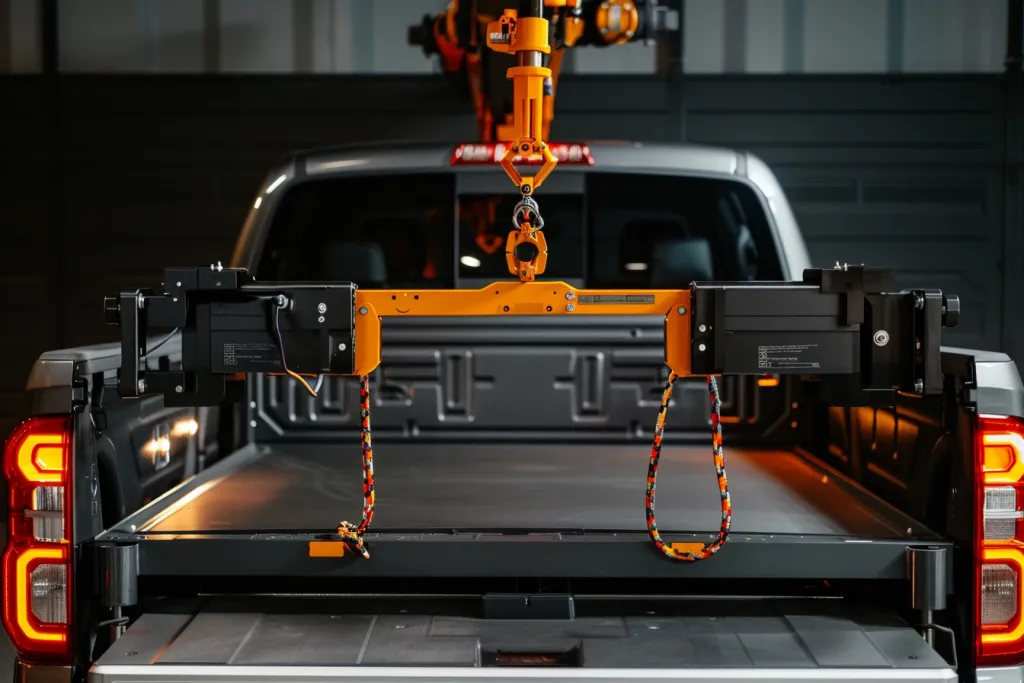Truck bed cranes have revolutionized the way we approach heavy lifting and material handling on the go. These powerful, compact devices offer unparalleled convenience for anyone needing to lift and transport heavy loads with ease. Whether you’re a contractor, farmer, or outdoor enthusiast, understanding the intricacies of truck bed cranes can significantly enhance your operational efficiency and safety. In this article, we delve deep into what truck bed cranes are, how they function, how to use them, their costs, and the top models available on the market today.
Table of Contents:
1. What is a truck bed crane?
2. How do truck bed cranes work?
3. How to use a truck bed crane
4. How much does a truck bed crane cost?
5. Top truck bed cranes on the market
What is a truck bed crane?

Truck bed cranes are compact lifting devices mounted onto the bed of a truck, designed to assist in loading and unloading heavy objects. These cranes are incredibly versatile, catering to a wide range of applications from construction and agriculture to recreational uses. Unlike full-sized cranes, truck bed cranes are smaller, more portable, and can be operated by a single person, making them an essential tool for mobile workforces.
The basic components of a truck bed crane include a base that mounts to the truck bed, a boom that extends and retracts, and a winch or hydraulic system for lifting. Depending on the model, these cranes can lift loads ranging from a few hundred pounds to several thousand pounds. This capability makes them ideal for handling equipment, building materials, and other heavy objects that would be otherwise difficult to move manually.
Truck bed cranes come in various designs and configurations. Some are manually operated with hand cranks, while others feature electric or hydraulic systems for more effortless operation. The choice of crane depends largely on the specific requirements of the job, the weight of the loads being handled, and the user’s budget and preference for convenience.
How do truck bed cranes work?

Truck bed cranes operate using a combination of mechanical leverage and hydraulic or electric power to lift and move heavy loads. The core of the crane is the boom, a long arm that extends outward and upward, providing the reach needed to lift objects from the ground to the truck bed or vice versa. The boom is typically adjustable, allowing for different lengths and angles to suit various tasks.
The lifting mechanism of a truck bed crane can be powered by different means. Manual models use a hand crank system, where the user manually winds a cable or rope to lift the load. These are suitable for lighter tasks and provide a cost-effective solution for occasional use. Electric models use a motor to operate the winch, significantly reducing the physical effort required and allowing for quicker and smoother lifting operations. Hydraulic models are the most powerful, using fluid pressure to lift heavy loads effortlessly and with precise control. These are ideal for professional use where efficiency and power are paramount.
A critical aspect of a truck bed crane’s functionality is its stability. The crane is mounted securely to the truck bed, often with additional support legs or outriggers that extend to the ground to prevent tipping. This ensures that the vehicle and crane remain stable even when handling maximum load capacities. Safety features such as overload protection and automatic braking systems further enhance the safe operation of these cranes.
How to use a truck bed crane

Using a truck bed crane effectively requires understanding its components and following proper operational procedures. The first step is to ensure the crane is securely mounted to the truck bed, with all bolts and fastenings checked for tightness. Depending on the model, you may also need to deploy outriggers or stabilizing legs to provide additional support and prevent the truck from tipping during operation.
Before lifting any load, it’s essential to assess the weight and ensure it does not exceed the crane’s rated capacity. Overloading can damage the crane and pose serious safety risks. Attach the load securely to the crane’s hook or lifting device using appropriate rigging techniques, such as slings or chains. Ensure the load is balanced and stable before beginning the lift.
Operate the crane using the control system provided. For manual models, this involves turning the hand crank to lift the load. For electric or hydraulic models, use the control panel or remote control to operate the winch or hydraulic system. Lift the load slowly and steadily, avoiding sudden movements that could destabilize the truck or the load. Once the load is lifted to the desired height, carefully maneuver it into position on the truck bed or the ground.
Safety should always be a top priority when using a truck bed crane. Wear appropriate personal protective equipment (PPE), such as gloves and safety glasses. Keep bystanders clear of the lifting area, and never position yourself under a suspended load. Regularly inspect the crane and its components for signs of wear or damage, and perform maintenance as needed to ensure optimal performance and safety.
How much does a truck bed crane cost?

The cost of a truck bed crane can vary widely based on several factors, including the crane’s lifting capacity, power source, brand, and additional features. Entry-level manual cranes, suitable for light-duty tasks, can be found for as little as $200 to $500. These basic models are ideal for occasional use and provide an affordable solution for those on a tight budget.
Mid-range electric cranes typically cost between $500 and $1,500. These cranes offer greater lifting capacities and convenience, with features such as remote controls and automatic winches. They are suitable for more frequent use and can handle a wider range of tasks, making them a popular choice for small businesses and contractors.
High-end hydraulic truck bed cranes are the most expensive, with prices ranging from $1,500 to $5,000 or more. These models offer the highest lifting capacities, often exceeding several thousand pounds, and come equipped with advanced features like wireless controls, telescoping booms, and enhanced safety systems. Hydraulic cranes are designed for heavy-duty professional use, providing the power and reliability needed for demanding applications.
In addition to the initial purchase price, it’s important to consider other costs associated with owning a truck bed crane. Installation costs, which can vary depending on the complexity of the setup and whether professional installation is required, should be factored in. Maintenance and repair costs should also be considered, as regular upkeep is essential to ensure the crane’s longevity and safe operation.
Top truck bed cranes on the market

Several truck bed crane models stand out in the market for their performance, reliability, and user-friendly features. One highly recommended model is the MaxxHaul 70238, a versatile and affordable option with a lifting capacity of up to 1,000 pounds. It features a manual winch and a swiveling boom, making it ideal for a wide range of light-duty applications.
For those seeking a more powerful electric option, the Viking Solutions Rack Jack Magnum is an excellent choice. With a 700-pound lifting capacity and an easy-to-use electric winch, this crane is perfect for medium-duty tasks. Its compact design and ease of installation make it a favorite among hunters, farmers, and small contractors.
At the top end of the market, the Venturo ET12KX-H is a premier hydraulic truck bed crane, boasting a lifting capacity of up to 6,000 pounds. This crane features a telescoping boom, wireless remote control, and advanced safety features, making it a top choice for professional users who need a reliable and robust lifting solution.
Conclusion:
Truck bed cranes offer a powerful and versatile solution for anyone needing to lift and transport heavy loads with ease. Understanding the different types of cranes, how they work, and how to use them safely can enhance your operational efficiency and safety. While the cost of truck bed cranes can vary widely, investing in a quality crane suited to your needs can provide long-term benefits and reliable performance. Whether you’re a contractor, farmer, or outdoor enthusiast, there’s a truck bed crane out there that can help you get the job done efficiently and safely.





 Afrikaans
Afrikaans አማርኛ
አማርኛ العربية
العربية বাংলা
বাংলা Nederlands
Nederlands English
English Français
Français Deutsch
Deutsch हिन्दी
हिन्दी Bahasa Indonesia
Bahasa Indonesia Italiano
Italiano 日本語
日本語 한국어
한국어 Bahasa Melayu
Bahasa Melayu മലയാളം
മലയാളം پښتو
پښتو فارسی
فارسی Polski
Polski Português
Português Русский
Русский Español
Español Kiswahili
Kiswahili ไทย
ไทย Türkçe
Türkçe اردو
اردو Tiếng Việt
Tiếng Việt isiXhosa
isiXhosa Zulu
Zulu